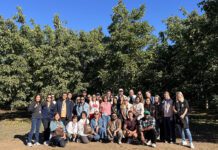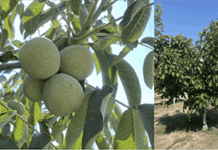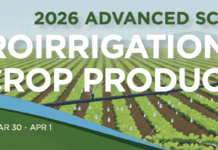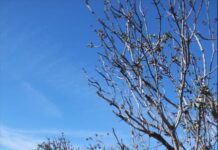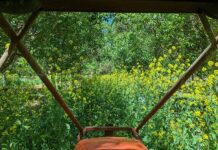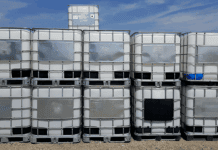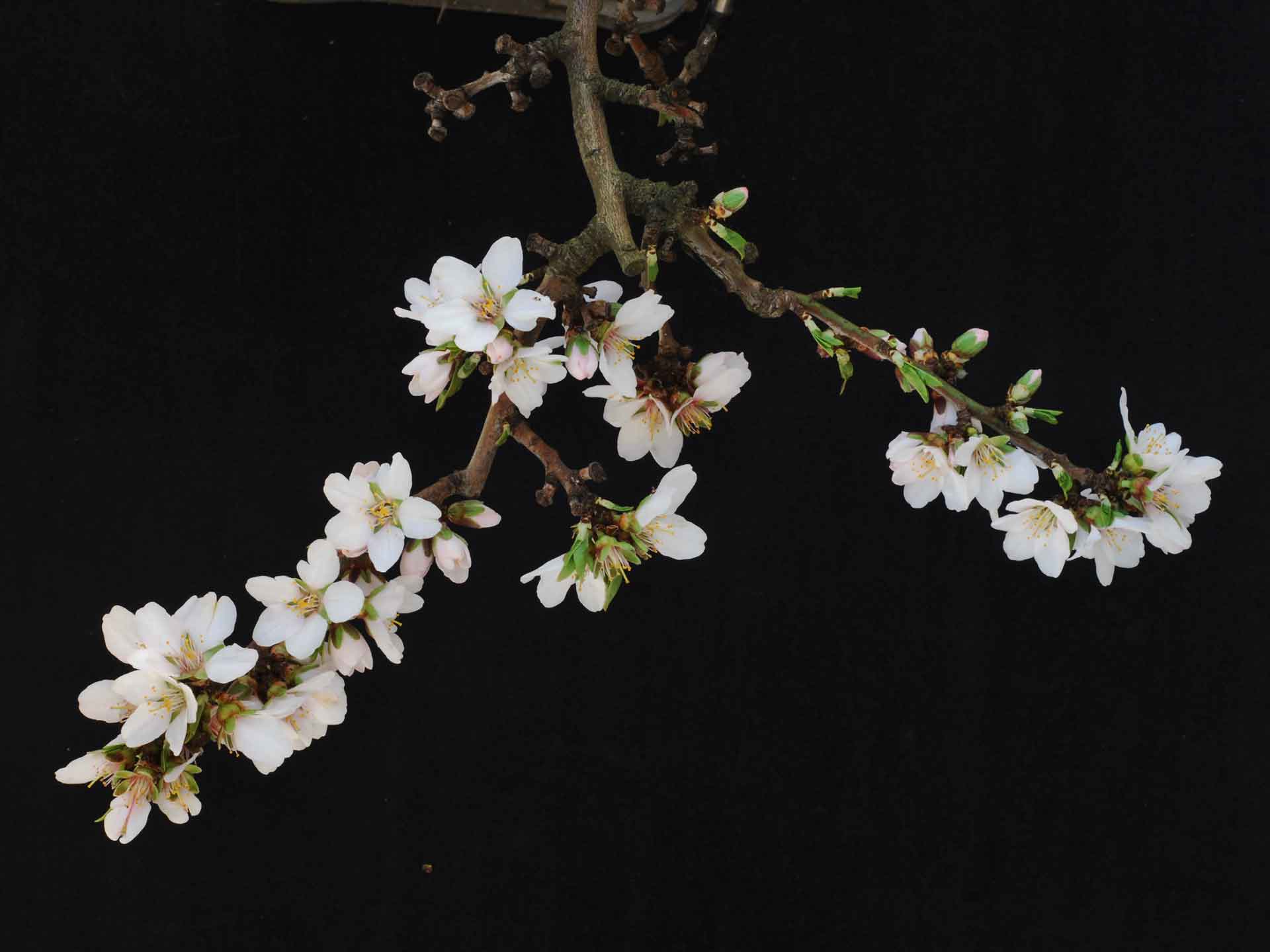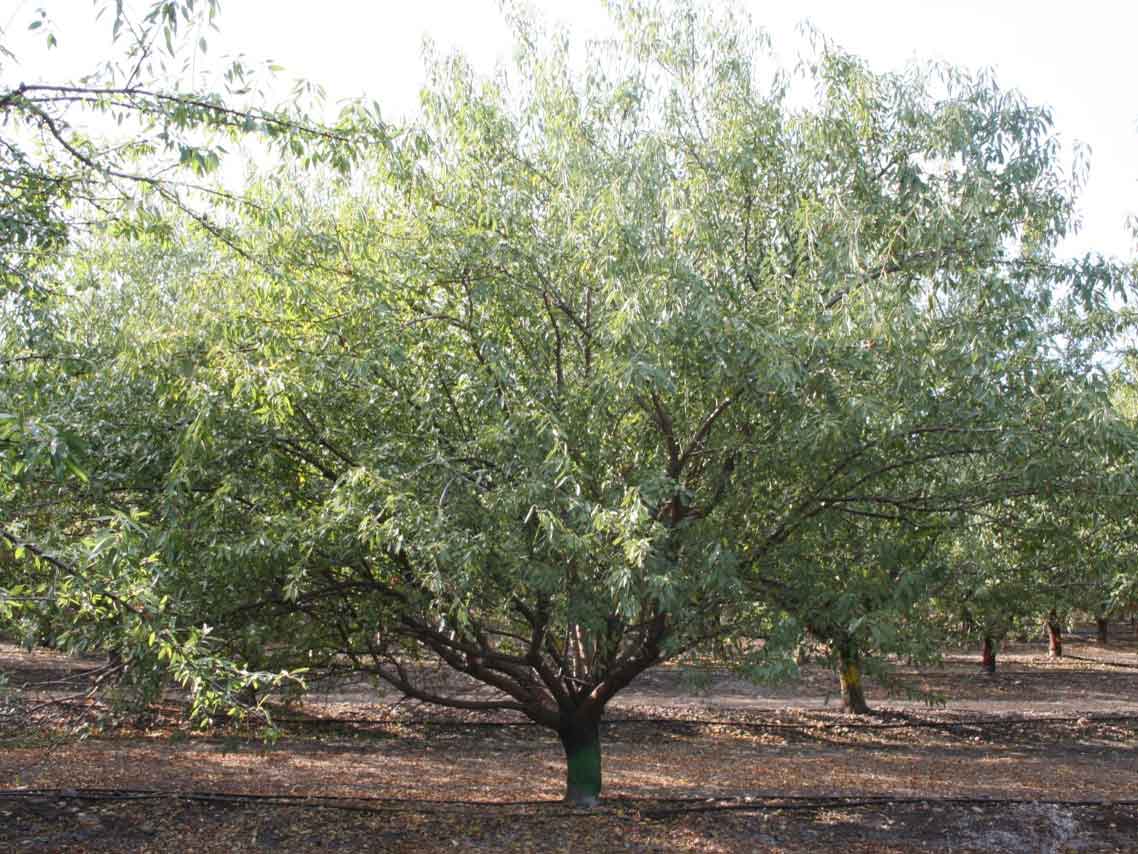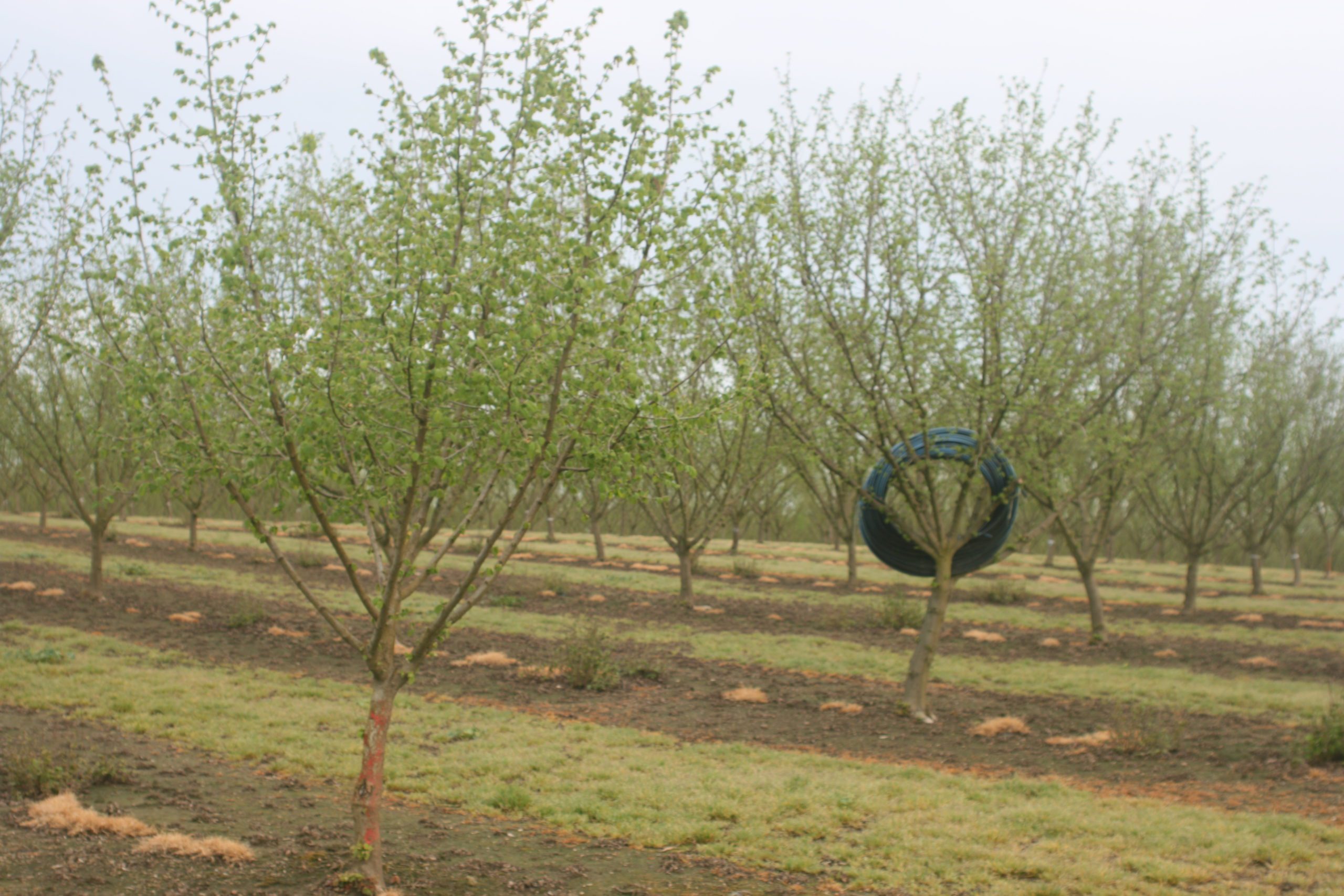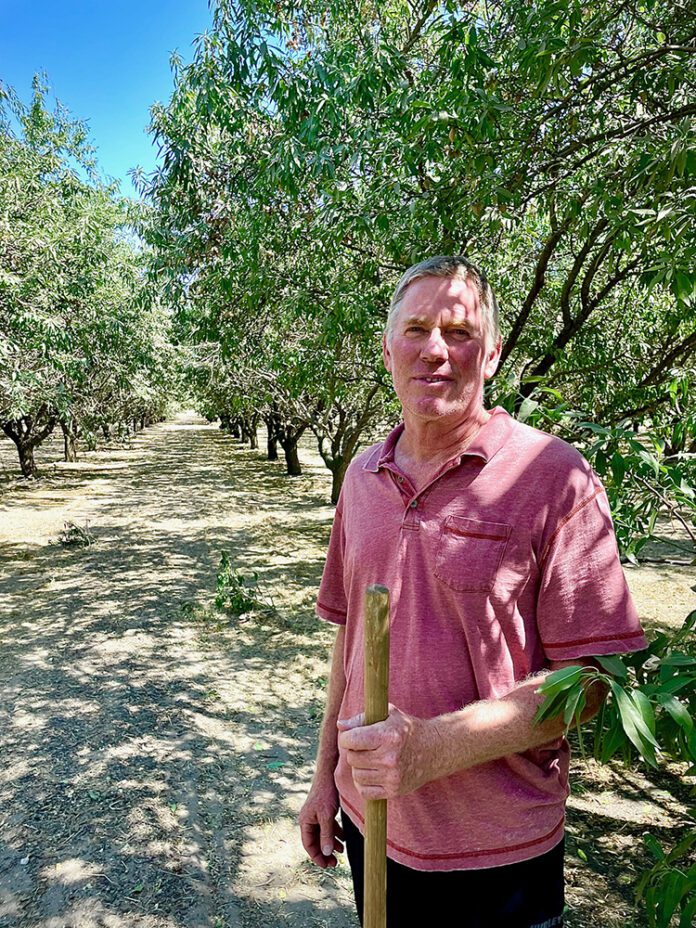
Rich Gemperle of Gemperle Family Farms grew up on the family farm in Turlock, Calif. doing chores for the egg-producing side of his family’s operation. At 18, he left home for college then Switzerland where he worked as a hydrologic engineer for 10 years. But farming drew him back home in the late 1990s.
Since then, he has focused on the almond-growing side of the business. With 2,000 acres of orchards that include small crops of walnuts and olives in addition to almonds, Gemperle enjoys applying his hydrogeology background to farming.
The result is a more scientific approach to farming focused on running trials to determine what practices work best. In fact, the newest project for Gemperle and his daughter, Tanya, who is pursuing a Ph.D. in sustainable agriculture, is their LaGrange Ranch, a piece of land embedded in nature where they are creating orchards that work within the existing landscape. They have opened the ranch to universities to use for research projects in addition to their own projects.
We asked Gemperle to share with West Coast Nut his thoughts on the state of the tree nut industry and sustainable agriculture.
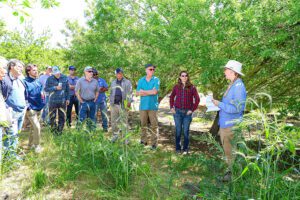
Q. Tell me a little bit about the history of your farming operation.
My dad immigrated from Switzerland in 1949. He studied poultry in Switzerland, so it started as an egg-producing company, and it’s always been an egg-producing company. We have a legacy of over 70, close to 75, years with that. I had an uncle who came in 1960, my dad’s brother, and they both in tandem started almond production in 1960.
I have four brothers and three sisters, and we’re all involved in the company. I run the farming side, the almonds, and I have three brothers who run the egg production side. The sisters are involved in various public relations and operations, too.
My background is I didn’t actually go straight from college into the business. I was a hydrologic engineer, and I did a reverse immigration back to Switzerland when I finished grad school. It wasn’t until after living there for about 10 years and having kids over there that I decided, “Yeah, maybe the family business is a good idea.” We were pretty far away from family.
So, I started in 1999, took over for my uncle on the almond side, and I’ve been doing almond farming for about 25 years now, after hydrogeology.
Now, the third generation is involved; my daughter is also working in the company on the almond side. On the egg side, there’s also a next generation working. She helps me with operations on the almond side, at least until September because she’s starting her Ph.D. in September, so she won’t have time for that anymore.
I have a background in geology, then hydrology and groundwater hydrology. She went into environmental sciences at Santa Cruz, did a master’s at Oxford, and now she’s starting at UC Davis on a Ph.D. track in sustainable farming.
Q. Does your background in groundwater hydrology help in the almond business?
Well, it’s an interesting question because I never knew that farming would be my field or profession later in life. But ironically, during my studies, I did a lot of soil chemistry, a lot of soils classes, a lot of hydrology classes.
As it turns out, hydrochemistry and soils come in pretty handy when you’re doing agriculture. So, yes, I do think even though I didn’t take a lot of pomology classes, I was well-prepared.
In hydrology, you run projects, and there’s a lot of in-field, in-situ research that you do to see what works and what doesn’t work. We do a lot of trials. Tanya is also trained more as a scientist than a farmer, so we take a very analytical or scientific approach to farming just because of our backgrounds.
Q. How have farming practices evolved in the last 25 years?
Well, there are a lot of buzzwords in the industry now about sustainability and regenerative agriculture and organic.
I guess we’re on that soapbox where we’re trying to farm as gently as we can. That means a lot of [integrated pest management] is involved in our decision-making and how we’re treating our soil. For example, we’re pretty unique because we have, on one side of the company, egg production, which produces an infinite supply of organic amendments for our almond production. That means we have composted manures that we apply to the fields, and we’ve been doing that for 40 years.
All the synthetic fertilizers, we really don’t need them. All the amendments that you would normally apply to soils, like potash, we don’t have to use on an annual basis. We’re just running our compost program and tracking how our soil nutrient levels respond to that, always tweaking that equation over time depending on our crop loads on an annual basis.
Q. Talk a little bit about sustainable and regenerative farming.
Our philosophy is pretty simple. It’s a simple question: we’re a family farm, so we don’t develop land, spin it off, and sell it for a profit. When we buy a parcel, we’re going to be the stewards of that parcel indefinitely.
I’m farming it for a generation, I’m handing it to the next generation, and I want to hand over something that is at least as good or better than how I received it. That means, are the farming practices sustainable, including our groundwater and surface water resources?
If we’re mining nutrients out of the soil, we want to track that and see if we’re depleting the soil or causing erosion on the property that’s irreversible. Every aspect of our farming operation is about looking at the long-term picture.
As far as fertility, organic matter and all the major parameters that look at soil health and habitat around it, we’re looking at the long-term projection: Is it improving or degrading?
I really like to emphasize that I feel like we’re really at the forefront of not just talking about sustainable farming but doing it, not just in our organic production but in our conventional production.
Tanya has been pretty aggressive at going after matching grants to help support those kinds of activities. We’ve done collaborative studies with American Farmland Trust (AFT), Community Alliance with Family Farmers (CAFF) and the Healthy Soils Program on the benefits of cover crops. As part of our sustainability plan, solar panel installations help offset our carbon footprint to as low as it can be.
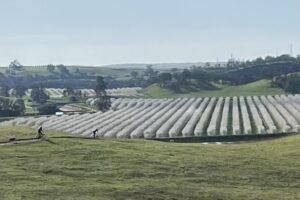
Q. What is your proudest achievement?
Right now, I’d have to say the La Grange Ranch. This is a new ranch that we started five years ago. It’s a blank canvas, and it’s a beautiful ranch. We’re trying to create an on-farm research collaborative project where universities can come and conduct research.
We learn, they learn, and we’re trying to make it a model ranch embedded in nature. It’s a very unique ranch; it has lakes on it, which makes it very sensitive in how we farm. We have to ensure we’re not affecting the riparian habitat around us. It’s challenging, but it’s also really rewarding.
So far, UC Merced has done work there. Stanford has done work there. I believe Davis has some work planned there. And we’re going to do a collaborative project with Fresno State on organic weed control.
Q. How did that idea come about?
When we purchased the ranch, my daughter and I thought this would be a great place to do collaborative research because we’re starting with a baseline on essentially virgin ground. We have a great baseline to start with, so we can look at the long-term effects of this change from pasture to agriculture into orchard systems and how the environment either accepts or rejects this proposition.
These are very sequestered fields. When you’re looking to do field trials in the valley, you have so much neighborhood effect because you might have a block surrounded by almonds under different regimes of management and programs.
Here, you have a very sequestered field separated by nature and riparian habitat. We also see a lot of other things that we just don’t experience in the valley, certain types of damage or insects that you wouldn’t normally think would be a problem. Lots of odd things happen when you farm embedded in nature.
If there are any researchers out there, we have an open-door policy. They can contact me directly or Tanya directly. Tanya will be reachable at UC Davis come this fall.
Q. What are the three things that keep you up at night about growing tree nuts?
One is the really poor prices over the last couple years. You do everything right, and you can barely break even. You’re lucky if you do that.
The second is there’s always something that blindsides you. Two years ago, it was a really wet spring, and we had new plantings going in. A tremendous amount of the newly planted trees developed Phytophthora. We had a disaster going on, and this year it was an orchard that experienced serious salinity from a high water table, and it started defoliating the trees. That’s what’s keeping me up at night currently.
Then, of course, weather is a really strange thing. You either get too much rain or too little rain, it’s never just the perfect amount. It’s either drought or too much water, and you’re always dealing with the consequences of that.
Q. Talk a little bit about the water situation.
We’re really fortunate the majority of the valley is really coming to terms with the over-pumping of groundwater resources. In Stanislaus County, with the Tuolumne River and Turlock Irrigation District and Modesto Irrigation District, we’re in a fairly water-secure area relative to other areas. That doesn’t mean we don’t have our own battles going on with the state over water rights, but I think everybody does.
But SGMA is having a major impact in many other areas, and we’re already seeing the repercussions of that with some of the GSAs going into probation. That being said, as we expanded as a company, just with my background in hydrogeology, we paid attention when purchasing new property about how resilient the water supply is or how robust it is in terms of reliability. So, most of the acres that we farm, the 2,000 acres we’re farming, are all in pretty good, water-secure areas of Merced and Stanislaus County.
Q. What do you think needs to happen to put the industry on the best possible route for the future?
I think in terms of growing commodities, I just feel like almonds, as a commodity, are a superfood. Sometimes it gets a bad rap; people say it’s an abuser of water. There’s been a battle in the media about almonds and their impact on the environment.
But when you look at an almond orchard and how we farm, and when you look at everything we’re doing for pollinators with our cover crop programs and our hedgerow programs, there’s a big emphasis now on pollinator health. We’re so reliant on them as a commodity.
I think the consumer needs to understand that almonds are pretty much on par or an average water user. We’re not over the median or under the median. It just takes water to grow food, and almonds aren’t any different.
Also, I think it would be great if farmers were in a situation where they got a fair price for their commodity. I feel bad for some of the walnut, grape or almond growers. Everything right now is kind of taking a beating as far as where production costs are, either above what our revenues are or maybe you break even. But it’s been a tough few years for the farming community.
The one thing is you have to be diversified. We’re diversified because we have an egg production side of our company, an almond production side and other entities. We’re not putting all our eggs in one basket, and that helps out in the long run, unless they all tank at the same time.
Q. What do you think the solution is to improve almonds’ reputation with the public?
I think the Almond Board is doing a commendable job trying to combat the bad press they get every once in a while. I think it’s more about educating consumers on the facts about water use and almond production’s impact on the environment. When you go into an almond orchard, even though it is a monocrop, in spring, it doesn’t look like a monocrop.
We’ve got cover crops that are four feet tall with mustard in the middles. We’ve got hedgerows along the edge of the orchards that provide beneficial habitat. We’re really trying to make it a sustainable environment.
We do a lot of joint research projects with local universities on a lot of our properties, specifically in that area of sustainability. There are certain pests that you just don’t want around, like ground squirrels; we don’t promote habitat for ground squirrels because they’re so damaging.
But deer come in, and we just kind of say, “Okay, we can tolerate a little bit of deer damage in our orchards.” They cause a little bit of problems, but it is what it is. Some of our blocks are embedded in nature, surrounded by habitat, so there’s not much you can do about that.
Q. What do you think are the biggest assets of the tree nut industry in California right now?
We’re growing a superfood, and we should be proud of that. It’s not like we’re growing tobacco (no offense to anyone growing tobacco), we grow a superfood. It’s wanted globally. We have a unique valley that supplies 80% of the global production. California should embrace this is a good quality product we’re producing. That’s the biggest asset, and I think we’re doing it as holistically as we can.
Q. Other than the LaGrange Ranch, how do you give back to both agriculture and the community?
We have a pretty strong philanthropic program in our company. We’ve given back quite a bit to the local university, Stanislaus State. We’ve got some endowed chairs there in the business department and the ag department.
We’re also donating a lot of products to the local food shelters, like United Samaritan.
And also on the arts side, the Turlock Community Theater, the Carnegie Arts Center, we’ve donated to them as well.
In addition, we donated 10 acres of land for soccer fields in Turlock.
Q. What kind of advice do you have for a young person interested in getting into the tree nut industry today?
If you’re going to get into the industry, I would say go through a four-year university or start with a junior college and get to the four-year level. Get the academic background. If you’re not growing up on a farm, then get the academic background. With that, you’ll probably get immersed in the local university farms.
Make sure it’s something you’re passionate about because it’s a lot of work, but if you’re passionate about it, it’s fun. It’s really rewarding because as a farmer, you have to wear a lot of hats. You have to be a plant pathologist, a soil chemist, a nutritionist, there are so many different things. If you’re working on the sales side, you’ve got your sales hat on.
But I think it’s really rewarding. I went away from farming for over 20 years, but when I came back, I found it interesting because there are never two days that are the same. You always seem to be working on something completely different, and you have to be willing to get your hands dirty. Farming is a hands-on job; you’re down in a trench sometimes trying to fix a pipe one day, and you didn’t expect that to be your job that day.
Q. Who was the biggest influence or mentor for you?
I would have to say my Uncle Walter. He was the one I shadowed at the very beginning just to get an understanding of almond farming. As a kid, I worked in the egg business, I did every dirty job you can imagine. I picked eggs, shoveled manure, poured concrete, built chicken houses, mostly on the poultry side. There are no child labor laws when the boss is your dad!
Pretty much at 18, I went away from farming for over 20 years. When I came back, I had to come up to speed fairly quickly, so I worked with Walter for a couple of years. He would have been my farming mentor.
Q. What do you think the biggest advancement has been in the field of tree nut growing in the time you’ve been doing it?
I would say probably the crop protection products that are out there compared to 30 years ago. There’s been a lot of new chemistries and more scientific approaches. There’s definitely been a lot of R&D put into these new products.
Unfortunately, organics are only about 1% of production, so there’s not a lot of R&D on the OMRI-certified products, but it would be great if there were more. If there was more of a market to back up the R&D, that needs to happen on the organic side. But even on the conventional side, there’s been a lot of progress in the type of products they’re putting out that are maybe a little safer for the environment.
Q. What advancements do you think will have a big impact on the future?
I would say the future is going to be much more automated. We’re doing that in our operations where labor is so expensive that we have to have as minimal hand labor as possible.
Every decision we make, whether it’s in the harvest process or in pruning, all the jobs that require a lot of hand labor, we’re trying to automate those. There are already autonomous tractors being prototyped, and there’s an autonomous shaker out there. We’ve even invested in some of the autonomous companies that are doing some of this work as a different type of diversification.




